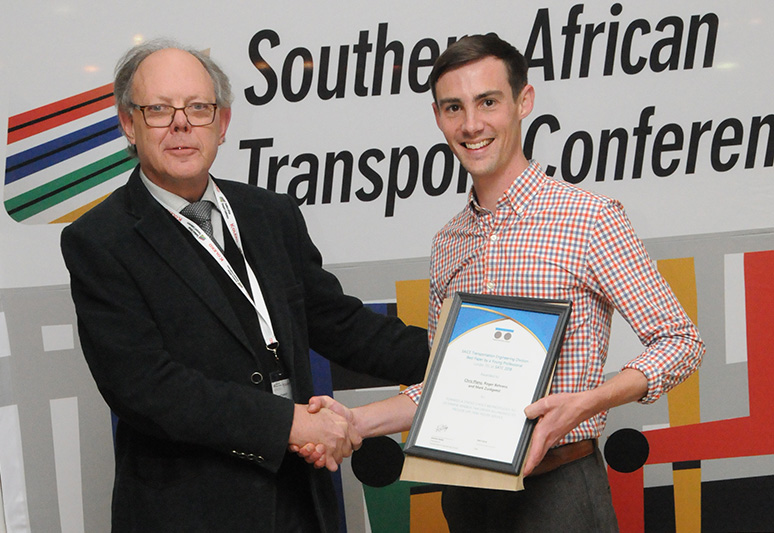Could minibus taxis go mainstream?
25 July 2018 | Story Sarah Middleton. Read time 6 min.
Chris Plano, a PhD candidate in the Department of Civil Engineering at the University of Cape Town (UCT), has won an award for his paper exploring the willingness of minibus-taxi owners and drivers to integrate into a hybridised public transport network in Cape Town.
He received the award for the South African Institution of Civil Engineering (SAICE) Transportation Engineering Division – Best Paper by a Young Professional at the Southern African Transport Conference 2018 held in Pretoria earlier in July.
Plano’s award-winning paper is titled “Towards a stated choice methodology to determine minibus-taxi driver willingness to provide off-peak feeder service”.
The MyCiti service – Cape Town’s integrated rapid transit (IRT) system – is made up of main trunk routes and smaller feeder services.
Plano said, “The idea is that the trunk service is bigger vehicles with more passengers on arterial roads – they are carrying the bulk of the passengers – and then feeders are picking people up on neighbourhood streets and bringing them to the trunk services to go longer distances.”

Following on from the City of Cape Town’s indication that they intend to use minibus taxis as a feeder service to hybridise public transport in the city in future roll-outs of the IRT system, Plano decided to address the question of whether minibus-taxi operators and drivers were willing to provide this service.
The necessity for the research stems from a mismatch between the service spans of train and large bus services and the minibus taxis.
“Minibus-taxi service ends at roughly 19:00 but you have trains, [Golden Arrow] buses and MyCiti buses coming in all the way until 22:00 or so,” said Plano.
“So you have this three-hour period where you’re getting off a train at, say, Mitchells Plain and you want to go to your house in the neighbourhood nearby; you’re pretty much stuck because minibus taxis don’t provide that service at night.”
“So you have this three-hour period where you’re ... pretty much stuck because minibus-taxis don’t provide that service at night.”
The idea behind Plano’s survey was to understand what it would take to convince the minibus-taxi drivers to provide a service that would fit in with the public transport operating hours.
Results of the survey
“The results were that we will need some sort of an incentive to get [minibus-taxi operators] to provide the service,” he said.
“We originally thought that maybe providing a police officer at the [taxi] rank – increased security – might be enough for them to operate later. But it’s clear from the results that that’s not the case and we would still need to incentivise them monetarily in some way.
“You’re impacting their business model, and if you want them to run when they don’t think it’s possible, it’s logical that you’d have to put some cash into that to make it work for passengers.”
“If you want them to run when they don’t think it’s possible, it’s logical that you’d have to put some cash into that to make it work for passengers.”
A new version of the survey
Plano said that the judges might have been impressed with his unusual utilisation of the standard survey.
“The stated choice survey that I used is a very well-known method in transport. But it’s usually used when you’re trying to decide what a person in the population would choose going to work; whether they would take the train, drive a car or take a taxi.
“I took it and reversed it, so instead of the users of the transport service being the respondents, it’s the providers of the service as respondents. So it’s kind of a new version of the survey.”
The survey took Plano roughly nine months from planning to completion.
“There were some challenges in doing the survey. Just in terms of making sure that everything was interpreted the way that I hoped it would be. For example, the term ‘profit’ – we had to make sure it was understood as profit and not as revenue.
“One of the biggest challenges was just to get the terminology down. In terms of administering the survey it generally went pretty smoothly.”
Plano, who is originally from Baltimore in the US, came to UCT to study under Associate Professor Roger Behrens and Dr Herrie Schalekamp because of their work with para-transit – public transport of a flexible, informal kind.
What are Plano’s plans for after his PhD?
“I would like to continue working in para-transit, which is a broad term for minibus-taxi-like services, probably on the African continent where there are a lot of these issues floating around.
“I’d like to keep trying to come up with improvements that bring minibus taxis and para-transit along in the best way possible.”
 This work is licensed under a Creative Commons Attribution-NoDerivatives 4.0 International License.
This work is licensed under a Creative Commons Attribution-NoDerivatives 4.0 International License.
Please view the republishing articles page for more information.
Research & innovation





































